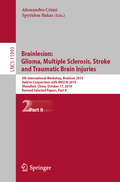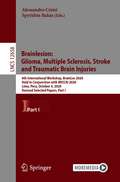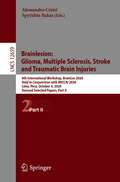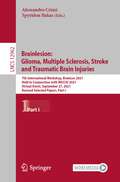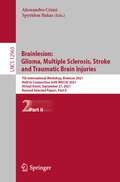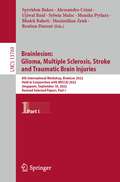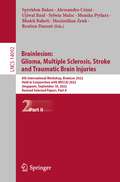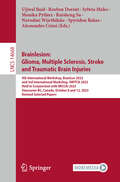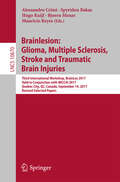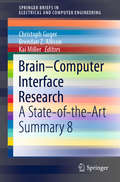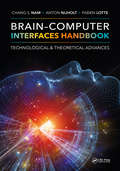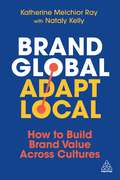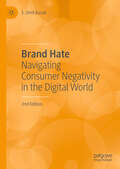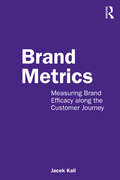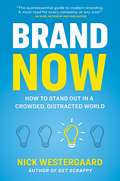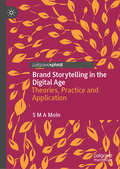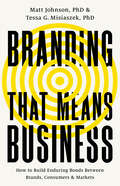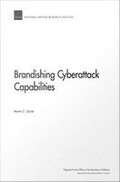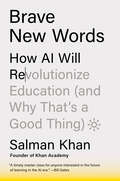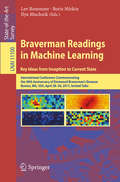- Table View
- List View
Brainlesion: 5th International Workshop, BrainLes 2019, Held in Conjunction with MICCAI 2019, Shenzhen, China, October 17, 2019, Revised Selected Papers, Part II (Lecture Notes in Computer Science #11993)
by Alessandro Crimi Spyridon BakasThe two-volume set LNCS 11992 and 11993 constitutes the thoroughly refereed proceedings of the 5th International MICCAI Brainlesion Workshop, BrainLes 2019, the International Multimodal Brain Tumor Segmentation (BraTS) challenge, the Computational Precision Medicine: Radiology-Pathology Challenge on Brain Tumor Classification (CPM-RadPath) challenge, as well as the tutorial session on Tools Allowing Clinical Translation of Image Computing Algorithms (TACTICAL). These were held jointly at the Medical Image Computing for Computer Assisted Intervention Conference, MICCAI, in Shenzhen, China, in October 2019. The revised selected papers presented in these volumes were organized in the following topical sections: brain lesion image analysis (12 selected papers from 32 submissions); brain tumor image segmentation (57 selected papers from 102 submissions); combined MRI and pathology brain tumor classification (4 selected papers from 5 submissions); tools allowing clinical translation of image computing algorithms (2 selected papers from 3 submissions.)
Brainlesion: 6th International Workshop, BrainLes 2020, Held in Conjunction with MICCAI 2020, Lima, Peru, October 4, 2020, Revised Selected Papers, Part I (Lecture Notes in Computer Science #12658)
by Alessandro Crimi Spyridon BakasThis two-volume set LNCS 12658 and 12659 constitutes the thoroughly refereed proceedings of the 6th International MICCAI Brainlesion Workshop, BrainLes 2020, the International Multimodal Brain Tumor Segmentation (BraTS) challenge, and the Computational Precision Medicine: Radiology-Pathology Challenge on Brain Tumor Classification (CPM-RadPath) challenge. These were held jointly at the 23rd Medical Image Computing for Computer Assisted Intervention Conference, MICCAI 2020, in Lima, Peru, in October 2020.* The revised selected papers presented in these volumes were organized in the following topical sections: brain lesion image analysis (16 selected papers from 21 submissions); brain tumor image segmentation (69 selected papers from 75 submissions); and computational precision medicine: radiology-pathology challenge on brain tumor classification (6 selected papers from 6 submissions). *The workshop and challenges were held virtually.
Brainlesion: 6th International Workshop, BrainLes 2020, Held in Conjunction with MICCAI 2020, Lima, Peru, October 4, 2020, Revised Selected Papers, Part II (Lecture Notes in Computer Science #12659)
by Alessandro Crimi Spyridon BakasThis two-volume set LNCS 12658 and 12659 constitutes the thoroughly refereed proceedings of the 6th International MICCAI Brainlesion Workshop, BrainLes 2020, the International Multimodal Brain Tumor Segmentation (BraTS) challenge, and the Computational Precision Medicine: Radiology-Pathology Challenge on Brain Tumor Classification (CPM-RadPath) challenge. These were held jointly at the 23rd Medical Image Computing for Computer Assisted Intervention Conference, MICCAI 2020, in Lima, Peru, in October 2020.* The revised selected papers presented in these volumes were organized in the following topical sections: brain lesion image analysis (16 selected papers from 21 submissions); brain tumor image segmentation (69 selected papers from 75 submissions); and computational precision medicine: radiology-pathology challenge on brain tumor classification (6 selected papers from 6 submissions). *The workshop and challenges were held virtually.
Brainlesion: 7th International Workshop, BrainLes 2021, Held in Conjunction with MICCAI 2021, Virtual Event, September 27, 2021, Revised Selected Papers, Part I (Lecture Notes in Computer Science #12962)
by Alessandro Crimi Spyridon BakasThis two-volume set LNCS 12962 and 12963 constitutes the thoroughly refereed proceedings of the 7th International MICCAI Brainlesion Workshop, BrainLes 2021, as well as the RSNA-ASNR-MICCAI Brain Tumor Segmentation (BraTS) Challenge, the Federated Tumor Segmentation (FeTS) Challenge, the Cross-Modality Domain Adaptation (CrossMoDA) Challenge, and the challenge on Quantification of Uncertainties in Biomedical Image Quantification (QUBIQ). These were held jointly at the 23rd Medical Image Computing for Computer Assisted Intervention Conference, MICCAI 2020, in September 2021. The 91 revised papers presented in these volumes were selected form 151 submissions. Due to COVID-19 pandemic the conference was held virtually.This is an open access book.
Brainlesion: 7th International Workshop, BrainLes 2021, Held in Conjunction with MICCAI 2021, Virtual Event, September 27, 2021, Revised Selected Papers, Part II (Lecture Notes in Computer Science #12963)
by Alessandro Crimi Spyridon BakasThis two-volume set LNCS 12962 and 12963 constitutes the thoroughly refereed proceedings of the 7th International MICCAI Brainlesion Workshop, BrainLes 2021, as well as the RSNA-ASNR-MICCAI Brain Tumor Segmentation (BraTS) Challenge, the Federated Tumor Segmentation (FeTS) Challenge, the Cross-Modality Domain Adaptation (CrossMoDA) Challenge, and the challenge on Quantification of Uncertainties in Biomedical Image Quantification (QUBIQ). These were held jointly at the 23rd Medical Image Computing for Computer Assisted Intervention Conference, MICCAI 2020, in September 2021. The 91 revised papers presented in these volumes were selected form 151 submissions. Due to COVID-19 pandemic the conference was held virtually.
Brainlesion: 8th International Workshop, BrainLes 2022, Held in Conjunction with MICCAI 2022, Singapore, September 18, 2022, Revised Selected Papers (Lecture Notes in Computer Science #13769)
by Alessandro Crimi Spyridon Bakas Ujjwal Baid Sylwia Malec Monika Pytlarz Bhakti Baheti Maximilian Zenk Reuben DorentThis book constitutes the refereed proceedings of the 8th International MICCAI Brainlesion Workshop, BrainLes 2022, as well as the Brain Tumor Segmentation (BraTS) Challenge, the Brain Tumor Sequence Registration (BraTS-Reg) Challenge, the Cross-Modality Domain Adaptation (CrossMoDA) Challenge, and the Federated Tumor Segmentation (FeTS) Challenge. These were held jointly at the Medical Image Computing for Computer Assisted Intervention Conference, MICCAI 2022, in September 2022. The 46 revised full papers presented in these volumes were selected form 65 submissions.The presented contributions describe the research of computational scientists and clinical researchers working on brain lesions - specifically glioma, multiple sclerosis, cerebral stroke, traumatic brain injuries, vestibular schwannoma, and white matter hyper-intensities of presumed vascular origin.
Brainlesion: 8th International Workshop, BrainLes 2022, Held in Conjunction with MICCAI 2022, Singapore, September 18, 2022, Revised Selected Papers, Part II (Lecture Notes in Computer Science #14092)
by Alessandro Crimi Spyridon Bakas Ujjwal Baid Sylwia Malec Monika Pytlarz Bhakti Baheti Maximilian Zenk Reuben DorentThis two volume-set LNCS 13769 and LNCS 14092 constitutes the refereed proceedings of the 8th International MICCAI Brainlesion Workshop, BrainLes 2022, as well as the Brain Tumor Segmentation (BraTS) Challenge, the Brain Tumor Sequence Registration (BraTS-Reg) Challenge, the Cross-Modality Domain Adaptation (CrossMoDA) Challenge, and the Federated Tumor Segmentation (FeTS) Challenge. These were held jointly at the Medical Image Computing for Computer Assisted Intervention Conference, MICCAI 2022, in September 2022. The 46 revised full papers presented in these volumes were selected form 65 submissions.The presented contributions describe the research of computational scientists and clinical researchers working on brain lesions - specifically glioma, multiple sclerosis, cerebral stroke, traumatic brain injuries, vestibular schwannoma, and white matter hyper-intensities of presumed vascular origin.
Brainlesion: 9th International Workshop, BrainLes 2023, and 3rd International Workshop, SWITCH 2023, Held in Conjunction with MICCAI 2023, Vancouver, BC, Canada, October 8 and 12, 2023, Revised Selected Papers (Lecture Notes in Computer Science #14668)
by Alessandro Crimi Spyridon Bakas Ujjwal Baid Sylwia Malec Monika Pytlarz Reuben Dorent Ruisheng Su Navodini WijethilakeThis book constitutes the refereed proceedings of the 9th International MICCAI Brain Lesion Workshop, BrainLes 2023, as well as the Stroke Workshop on Imaging and Treatment Challenges, SWITCH 2023. These events were held in conjunction with the Medical Image Computing for Computer Assisted Intervention Conference, MICCAI 2023, during October 8-12, 2023. The 15 revised full papers presented in this volume were selected form 23 submissions. They describe the research of computational scientists and clinical researchers working on brain lesions, and specifically glioma, multiple sclerosis, cerebral stroke, traumatic brain injuries, vestibular schwannoma, and white matter hyper-intensities of presumed vascular origin.
Brainlesion: Glioma, Multiple Sclerosis, Stroke and Traumatic Brain Injuries
by Bjoern Menze Alessandro Crimi Mauricio Reyes Spyridon Bakas Hugo KuijfThis book constitutes revised selected papers from the Third International MICCAI Brainlesion Workshop, BrainLes 2017, as well as the International Multimodal Brain Tumor Segmentation, BraTS, and White Matter Hyperintensities, WMH, segmentation challenges, which were held jointly at the Medical Image computing for Computer Assisted Intervention Conference, MICCAI, in Quebec City, Canada, in September 2017. The 40 papers presented in this volume were carefully reviewed and selected from 46 submissions. They were organized in topical sections named: brain lesion image analysis; brain tumor image segmentation; and ischemic stroke lesion image segmentation.
Brain–Computer Interface Research: A State-of-the-Art Summary 8 (SpringerBriefs in Electrical and Computer Engineering #6)
by Brendan Z. Allison Christoph Guger Kai MillerThe Annual BCI Research Awards are international prizes that recognize the top new projects in brain-computer interface (BCI) research. This book contains summaries of the key projects from the 2018 BCI Research Award. Each article is authored by the group of researchers who developed the project, and articles have been updated with new progress achieved since 2018. They are complemented by an introduction by the editors together with a chapter of highlights and interviews with the 2018 award winners. One of the prominent trends in recent years has been the development of BCIs for new patient groups; many chapters in this book present emerging and novel research directions likely to become more prevalent in the near future.
Brain–Computer Interfaces Handbook: Technological and Theoretical Advances
by Anton Nijholt Fabien Lotte Chang S. NamBrain–Computer Interfaces Handbook: Technological and Theoretical Advances provides a tutorial and an overview of the rich and multi-faceted world of Brain–Computer Interfaces (BCIs). The authors supply readers with a contemporary presentation of fundamentals, theories, and diverse applications of BCI, creating a valuable resource for anyone involved with the improvement of people’s lives by replacing, restoring, improving, supplementing or enhancing natural output from the central nervous system. It is a useful guide for readers interested in understanding how neural bases for cognitive and sensory functions, such as seeing, hearing, and remembering, relate to real-world technologies. More precisely, this handbook details clinical, therapeutic and human-computer interfaces applications of BCI and various aspects of human cognition and behavior such as perception, affect, and action. It overviews the different methods and techniques used in acquiring and pre-processing brain signals, extracting features, and classifying users’ mental states and intentions. Various theories, models, and empirical findings regarding the ways in which the human brain interfaces with external systems and environments using BCI are also explored. The handbook concludes by engaging ethical considerations, open questions, and challenges that continue to face brain–computer interface research. Features an in-depth look at the different methods and techniques used in acquiring and pre-processing brain signals, extracting features, and classifying the user's intention Covers various theories, models, and empirical findings regarding ways in which the human brain can interface with the systems or external environments Presents applications of BCI technology to understand various aspects of human cognition and behavior such as perception, affect, action, and more Includes clinical trials and individual case studies of the experimental therapeutic applications of BCI Provides human factors and human-computer interface concerns in the design, development, and evaluation of BCIs Overall, this handbook provides a synopsis of key technological and theoretical advances that are directly applicable to brain–computer interfacing technologies and can be readily understood and applied by individuals with no formal training in BCI research and development.
Branching Story, Unlocked Dialogue: Designing and Writing Visual Novels
by Toiya Kristen FinleyThis book covers the distinguishing characteristics and tropes of visual novels (VNs) as choice-based games and analyzes VNs like 999: Nine Hours, Nine Persons, Nine Doors; Hatoful Boyfriend; and Monster Prom, some of the best examples of the genre as illustrations. The author covers structuring branching narrative and plot, designing impactful and compelling choices, writing entertaining relationships and character interactions, understanding the importance of a VN’s prose, and planning a VN’s overall narrative design and story delivery. The book contains exercises at the end of chapters to practice the techniques discussed. By the end of the book, if the reader finishes all the exercises, they may have several portfolio pieces or a significant portion of their own VN project designed. Features: Discusses different aspects and genres of VNs, what makes them enjoyable, and successful techniques developers can incorporate into their own games Analyzes various VNs and choice-based games that use these successful techniques Shares tips from developers on portfolio pieces, hiring a team to work on VNs, and plotting and outlining VNs Branching Story, Unlocked Dialogue: Designing and Writing Visual Novels is a valuable resource for developers and narrative designers interested in working on VNs. The book will show them how they can design their own VN projects, design branching narratives, develop entertaining plots and relationships, design impactful and compelling choices, and write prose that’s a pleasure to read.
Brand Global, Adapt Local: How to Build Brand Value Across Cultures
by Nataly Kelly Katherine Melchior RayBuilding global brands provides companies with access to new markets, new opportunities and new ideas that can stimulate innovation and diversify revenue streams. However, with new opportunities comes additional challenges that marketers need to navigate in order to build an international brand. If a brand wants to thrive in an international market, it needs to understand the different consumers and the nuances of the cultures in which they live. The best brands in the world do this by remaining relentlessly curious about their customers and their markets, immersing themselves in the culture and embracing new and different ways of seeing, understanding and being. Learn how to develop this global mindset and how to build this into your marketing strategy from some of the world's leading global brands such as Nike, LVMH, Nestlé, Shiseido, Natura and Marriott. This book explores the challenges these brands faced across international markets and how they balance remaining true to their brand values with creating local resonance.Covering everything from how applying cultural understanding to interpreting data delivers exceptional consumer insight to how you can localize campaigns without losing the core brand identity, this book delivers all you need to know about scaling a brand globally packed full of powerful insight from leading marketers.
Brand Hate: Navigating Consumer Negativity in the Digital World
by S. Umit KucukThis book focuses on the concept of “brand hate” and consumer negativity in today’s digital markets. It explores the emotional detachment consumers generate against valued brands and how negative experiences affect their and other consumers' loyalty. It is almost impossible not to run into hateful language about companies and their brands in today’s digital consumption spaces. Consumer hostility and hate is not hidden and silent anymore but is now openly shared on many online anti-brand websites, consumer social networking sites, and complaint and review boards. The book defines consumer brand hate and discusses its dimensions, antecedents, and consequences as well as the semiotics and legality of such brand hate activities based on current brand dilution arguments. It describes the situations which lead to anti-branding and how consumers choose to express their dissatisfaction with a company on individual and social levels. This newly updated edition discusses recent research findings from brand hate literature with new cases and extended managerial analysis. Thus, the book provides strategic perspectives on how to handle such situations to achieve better functioning markets for scholars and practitioners in marketing, psychology, and consumer behavior.
Brand Love: Building Strong Consumer-Brand Connections
by Lydia MichaelThe best brands evoke the emotions of their customers by tapping into their hearts and minds.Individuals connect with brands the same way they connect with people. As a marketer, it's your responsibility to cultivate that relationship with your consumers. In this book, marketing and brand strategist Lydia Michael breaks down the process of building culturally inclusive, long-lasting consumer-brand relationships.Brand Love describes how brands appeal to the emotions of their consumers and why everybody benefits when brands earn the love of their customers. The author explains what marketers need to do to make consumers fall for their brands. The book builds on in-depth brand interviews and insights from companies such as Huda Beauty, LEGO and Toyota. She also shares what she has learned through client work and her observations in multicultural settings. Offering insight into the use of emotional and rational drivers, she introduces a "brand love" model designed to inspire brand loyalty and advocacy. With emotional elements such as humanization, personalization and trust alongside rational elements like relevance, differentiation and innovation, the author highlights the best ways to create or reinforce brand love to help your organization remain profitable and a source of inspiration, even during challenging times.Whether you're a marketer for a big or small brand, Brand Love will show you how to capture the hearts of your customers.
Brand Media Strategy
by Antony YoungToday's sophisticated media landscape offers more tools and platforms, for the savvy marketer than ever before. Media & brand expert Antony Young explores how today's most innovative marketers are meeting the challenge by employing the latest media tools in ways never before seen to grow their brands, and getting unprecedented results.
Brand Media Strategy: Integrated Communications Planning in the Digital Era
by A. YoungToday's sophisticated media landscape offers more tools and platforms, for the savvy marketer than ever before. Media & brand expert Antony Young explores how today's most innovative marketers are meeting the challenge by employing the latest media tools in ways never before seen to grow their brands, and getting unprecedented results.
Brand Metrics: Measuring Brand Efficacy along the Customer Journey
by Jacek KallThis book gathers and explains the key brand analysis tools that measure brand effectiveness and awareness along the customer journey. Rather than considering how to build and manage a brand, Brand Metrics shows students the methods by which they can assess the current market position of the brand and design effective strategies for the future. Each chapter follows the same logical and accessible structure, defining each metric and its usage, presenting the calculations, showing how the data should be interpreted, offering case studies and examples, presenting recommendations and offering questions for further discussion. The metrics covered in the book correspond with the customer journey, moving through measuring brand awareness, consideration and purchase, to customer loyalty and brand advocacy, and finally an overall analysis of the brand’s strength. The book not only shows the formula for a metric and explains how it should be interpreted, but also considers what each metric really measures, how it impacts the brand’s equity and how it is related to other metrics. As such it should be perfect recommended reading for advanced undergraduate and postgraduate students of Strategic Brand Management, Marketing Planning and Strategy, Marketing and Branding Metrics.
Brand Now: How to Stand Out in a Crowded, Distracted World
by Nick WestergaardCapture their attention-and keep it! With the rise of digital media, you'd think it would be easier than ever to be heard. Yet, most messages fail to cut through the clutter. Consumers are overwhelmed. Ads alone aren't effective. And you can't just churn out content and connect on every social network. To stand out today, you need to start with your brand. Brand Now uncovers the new rules of branding in our complex and chaotic world. Written by the author of Get Scrappy, the digital marketing bible for business, this latest book explains how to build brands that resonate both online and off. The book helps you: Create a brand with meaning * Reinforce it with the right touchpoints * Hone your brand's unique story * Share it through engaging content * Cultivate a sense of community * Craft a coherent experience * Stand out with simplicity and transparency The world may be growing louder, but with Brand Now's big ideas and practical toolbox, you can break through the noise-and win a place in the hearts and minds of your customers.
Brand Storytelling in the Digital Age: Theories, Practice and Application
by S M MoinInextricably linked to human evolution, storytelling has always been a key element of the marketer’s toolkit. However, despite extensive practitioner interest, academic research on the topic currently falls short. This book highlights how storytelling has evolved from an ancient art to contemporary marketing science, placing it in the context of digitisation and social media. It reflects the dramatic shift in brand storytelling in which marketers are in the driving seat, leaving consumers to do the navigating.Based within the context of AI, the influence of VR, AR, big data, and new media, this book predicts a creative renaissance in brand storytelling; one that will be at the intersection of science, art and humanity. The author suggests that there will be a shift from ad to art through the use of cognition and emotion, data and fiction. It suggests that through storytelling, brands will be able to connect with their customers’ hearts and minds.Drawing upon interdisciplinary research on neuroscience, emotional attachment and narrative theory, the book critically analyses existing theories, practices and applications of storytelling, providing a platform for debate between academics, researchers and practitioners.
Branding for Bloggers: Tips to Grow Your Online Audience and Maximize Your Income
by New York Institute of Career Development Zach HellerThere are more than 54,000 new blogs started every day around the world. The stark reality is that most will fail because bloggers don't have enough information on marketing themselves. The key to any successful marketing plan is a strong brand. Branding for Bloggers features tried-and-true, it-worked-for-me methods of branding from a rich mix of professional bloggers and branding experts. Bloggers will learn how to define their brand, establish it to grow the reach of their blog, and use their new brand identities to start earning money online.
Branding that Means Business: How to Build Enduring Bonds between Brands, Consumers and Markets
by Matt Johnson Tessa G MisiaszekA revelatory guide on how to build, sustain and grow a brand. A brand is either beloved, or it&’s noise. We live in a fast-paced world of immediate gratification where consumers can listen to any song, watch any movie, or read any article, with the touch of a few buttons. They are peppered with hyper-personalized targeting for products that can be ordered seamlessly and arrive within hours. And if your brand isn&’t the first to come to mind, they&’ll click that button and it&’ll be delivered by someone else. So how do you make sure your brand connects with consumers? Branding that Means Business draws from the authors&’ experience and business literature as well as psychology, sociology, and even anthropology to show readers that while any brand serves the business, the mechanisms that enable it are all about connecting with people. Readers will learn how to create, maintain, and operationalize their brand, and think creatively about how to differentiate their product and most importantly, make consumers fall in love with it.
Brandishing Cyberattack Capabilities
by Martin C. LibickiDeterrence is possible only when others have at least a good idea of possible U.S. military reprisals, but cyberattack capabilities resist such demonstration. This report explores ways they can be and under what circumstances, then goes on to examine the difficulties and the drawbacks. Such "brandishing" is no panacea and could even backfire if misinterpreted. Its success also relies on the strength of other elements of the deterrence posture.
Brave New Words: How AI Will Revolutionize Education (and Why That's a Good Thing)
by Salman Khan&“A timely masterclass for anyone interested in the future of learning in the AI era.&”—Bill Gates&“This book is required reading for everyone who cares about education.&”—Adam Grant, #1 New York Times bestselling author of Hidden Potential and Think Again, and host of the podcast Re:Thinking&“Read this book. It&’s the most fascinating and important account of how AI will transform the way we learn.&”—Walter Isaacson, #1 New York Times bestselling authorFrom the founder of Khan Academy, the first book on the AI revolution in education, its implications for parenting, and how we can best harness its power for good.Whether we like it or not, the AI revolution is coming to education. In Brave New Words, Salman Khan, the visionary behind Khan Academy, explores how artificial intelligence and GPT technology will transform learning, and offers a road map for teachers, parents, and students to navigate this exciting (and sometimes intimidating) new world.A pioneer in the field of education technology, Khan examines the ins and outs of these cutting-edge tools and how they will revolutionize the way we learn and teach. For parents concerned about their children&’s success, Khan illustrates how AI can personalize learning by adapting to each student&’s individual pace and style, identifying strengths and areas for improvement, and offering tailored support and feedback to complement traditional classroom instruction. Khan emphasizes that embracing AI in education is not about replacing human interaction but enhancing it with customized and accessible learning tools that encourage creative problem-solving skills and prepare students for an increasingly digital world.But Brave New Words is not just about technology—it&’s about what this technology means for our society, and the practical implications for administrators, guidance counselors, and hiring managers who can harness the power of AI in education and the workplace. Khan also delves into the ethical and social implications of AI and large language models, offering thoughtful insights into how we can use these tools to build a more accessible education system for students around the world.
Braverman Readings in Machine Learning. Key Ideas from Inception to Current State: International Conference Commemorating the 40th Anniversary of Emmanuil Braverman's Decease, Boston, MA, USA, April 28-30, 2017, Invited Talks (Lecture Notes in Computer Science #11100)
by Boris Mirkin Lev Rozonoer Ilya MuchnikThis state-of-the-art survey is dedicated to the memory of Emmanuil Markovich Braverman (1931-1977), a pioneer in developing machine learning theory.The 12 revised full papers and 4 short papers included in this volume were presented at the conference "Braverman Readings in Machine Learning: Key Ideas from Inception to Current State" held in Boston, MA, USA, in April 2017, commemorating the 40th anniversary of Emmanuil Braverman's decease. The papers present an overview of some of Braverman's ideas and approaches.The collection is divided in three parts. The first part bridges the past and the present and covers the concept of kernel function and its application to signal and image analysis as well as clustering. The second part presents a set of extensions of Braverman's work to issues of current interest both in theory and applications of machine learning. The third part includes short essays by a friend, a student, and a colleague.
